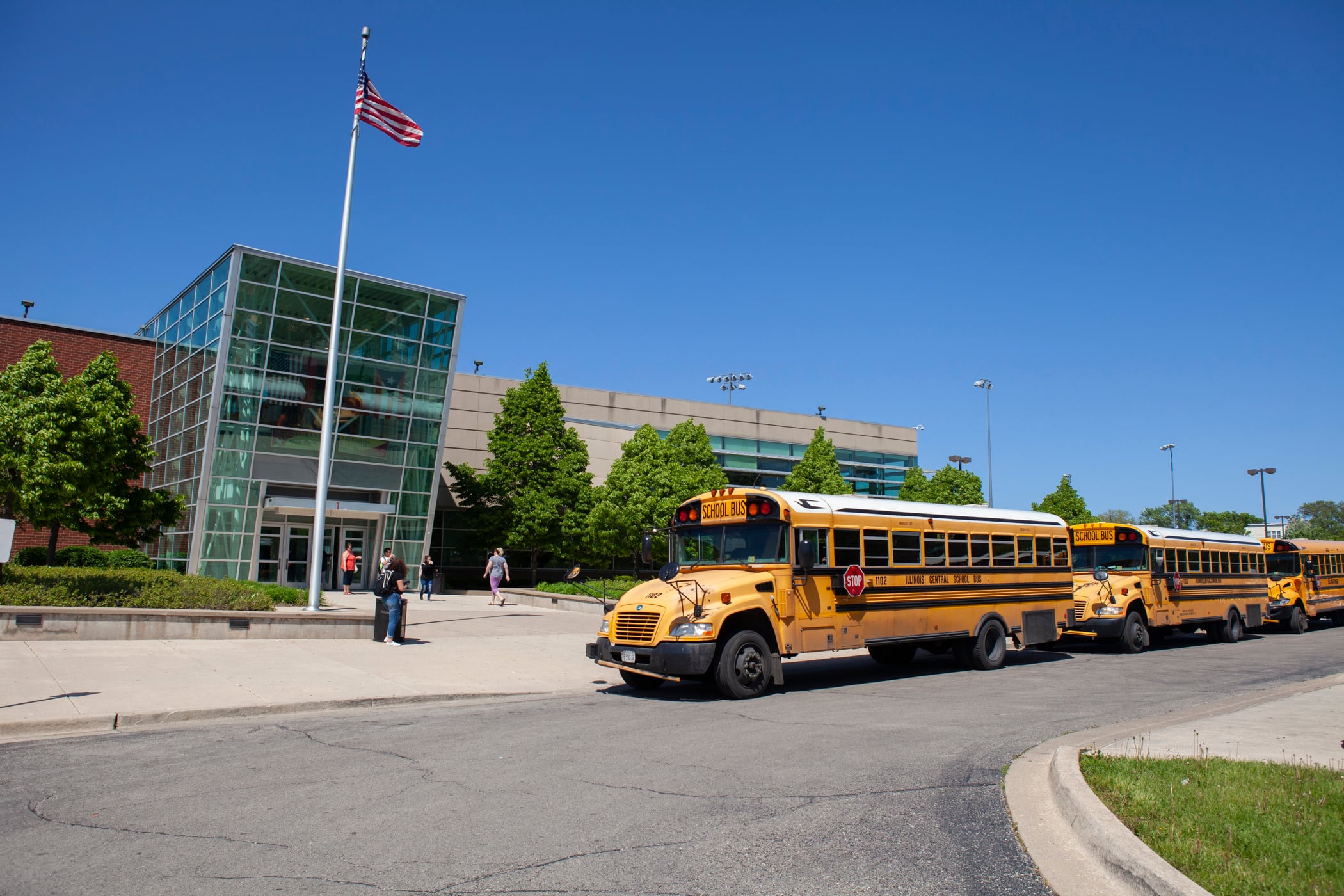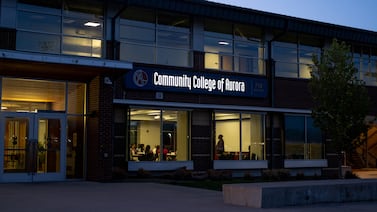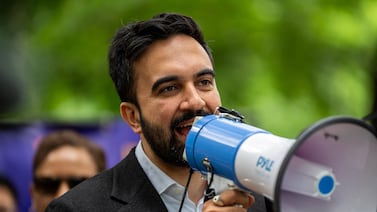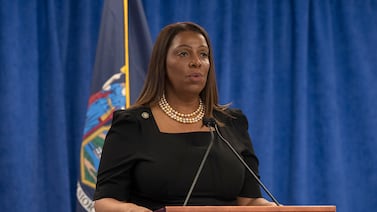Data analysis by Thomas Wilburn.
Sign up for Chalkbeat Chicago’s free daily newsletter to keep up with the latest education news.
Four months after Chicago Public Schools significantly cut back bus service to meet the needs of children with disabilities, new data indicates hundreds of routes are carrying fewer than 10 students.
New data obtained by Chalkbeat Chicago details more than 1,000 bus routes for 7,350 students with disabilities whose Individualized Education Programs, or IEPs, require transportation services. It offers a glimpse into how the district is attempting to shorten bus travel times for these students, as required by the state under a corrective action plan issued last year.
The bus routes included in the data are carrying students to 540 different schools.
The data was captured on Oct. 23 and filed by CPS with the state just before Thanksgiving, as part of the corrective action plan. It outlines the number of students with IEPs per route, their schools, pick-up times, and the third-party company that operates each route.
However, the data does not include students who have 504 plans — another type of legal document for students with disabilities — or homeless students, who are also entitled to transportation. District officials said the routes may include those students. One week before the data was captured, the district said it had routed a total of 8,105 students.
Chalkbeat’s analysis of the route data for 7,350 students with IEPs found:
- There are an average 6.9 students with IEPs per route
- 785 of the more than 1,000 routes have 10 or fewer children with IEPs
- 59 routes — or 5.4% — transport one child with an IEP
- The maximum number of students with an IEP per route is 26
The data does not clarify what sized buses travel on each route, how many routes include adult paraprofessionals who are assigned to assist students who have IEPs, how many other children who do not have IEPs might ride on the route, or how many empty seats there are on each bus route.
The new information raises questions about how students with IEPs are assigned to schools — often far from where they live — rather than provided services at schools in their communities. It also comes as parents of students whose bus service was cut earlier this year continue to put pressure on the district to provide transportation to their students, most of whom attend magnet and selective enrollment schools.
District officials continue to cite a national bus driver shortage as the core reason for its transportation troubles. CPS currently has 715 of the roughly 1,300 drivers it needs, officials said.
“This is an evolving non-stagnant situation with new requests and availability,” a district spokesperson said in an email.
Advocates for students with disabilities cautioned that the data does not necessarily mean there’s room on school buses for more students. Students with disabilities are legally owed transportation under federal law, and adding general education students to their existing routes “muddies the waters” of those legal rights, said Miriam Bhimani, a CPS parent and advocate whose complaint placed the district under state watch regarding transportation rights for students with IEPs.
CPS has struggled to provide bus transportation
The scope of busing provided by CPS has contracted significantly in recent years. As recently as 2019, the district budgeted $120 million to bus nearly 20,000 students, according to budget documents. This fiscal year, the district planned to budget $146 million as it pared down the number of students it was serving.
Since the onset of the COVID-19 pandemic, CPS has been struggling to provide reliable bus transportation. Last year, about 3,000 CPS students with disabilities were on routes longer than an hour. The state put the district under corrective action last year to reduce ride times to less than an hour, which Illinois requires districts to “make every effort” to do.
In July, officials announced CPS would only bus students with disabilities and those who are homeless — groups legally entitled to transportation — and offered CTA passes to about 5,500 general education students and their parents. They also offered families of students with disabilities and those in temporary housing up to $500 in monthly stipends to cover their own transportation costs.
In October, district officials said about 8,100 students, most of whom have IEPs, were routed for busing to and from school. Another 3,948 families of students with disabilities opted to take the monthly reimbursements, CPS officials told the state in a letter dated Nov. 17.
Chicago is not alone in struggling with a shortage of bus drivers. U-46, Illinois’s second largest school district, has also experienced a driver shortage affecting students with disabilities, the Courier-News reported last month, but a U-46 spokesperson said it is currently providing busing to about 22,000 students.
After reiterating its bus driver shortage, CPS officials wrote in the Nov. 17 letter that it “paused providing transportation to families of general education students in magnet or selective enrollment programs” this year “in an effort to ensure” all students whose IEPs require transportation “are routed in a timely manner, and every effort is made to prevent students from riding longer than sixty minutes.”
After bus service was cut for general education students, district officials reported in late September a vast improvement in commute times for students with disabilities, with 47 children on rides longer than an hour. But those travel times have since worsened: As of last week, 116 students with disabilities were on routes longer than an hour, according to a CPS presentation to City Council members.
As recently as last week, district officials cast doubt on whether they would offer transportation to general education students.
But families of general education students in magnet and selective enrollment programs continue to show up at Chicago school board meetings to advocate for busing.
At a Wednesday meeting, a student from Kenwood Academic Academic Center said he and his brother used to take the bus to school together. This year, however, his brother takes a paratransit vehicle that doesn’t have other students on it and “wishes he wasn’t alone in the car.”
That student directed a question to transportation officials and board members at the meeting: “Why are they not routing as many students as possible into empty seats?”
But it’s not that simple, according to some advocates for students with disabilities. Adding many more students to existing routes could again worsen travel times for some students with disabilities, who have a federally protected right to transportation.
Adding students to routes isn’t simple
Advocates for students with disabilities said the data from October raises questions about how students with disabilities are assigned to schools — sometimes far outside their communities. Some of these children, advocates noted, are traveling far distances to therapeutic day schools, which provide more specialized instruction.
An example is Soaring Eagle Academy in suburban Lombard, located roughly 21 miles west of the downtown, where eight CPS students arrive each morning using three different bus routes, the data shows.
Terri Smith-Roback, a CPS parent who co-filed complaints with the state regarding transportation rights for students with disabilities, said she’s worried about long and “inefficient” rides for students traveling to therapeutic day schools. She’s heard from parents of these children who are riding the bus more than two hours each way and knows of one instance where a large yellow bus was transporting six kids to one of the schools.
District officials said some routes have fewer students “due to distance, medical equipment, and/or required bus aides that will require less students in the vehicle.” They also said that many routes use smaller vehicles, which have less space than a traditional yellow school bus.
About one-third of the more than 1000 routes detailed in the data are paratransit, which are usually smaller vehicles that provide individualized routes for students with disabilities, district officials told the state in a letter obtained by Chalkbeat.
Bhimani said the data highlights a larger problem with how the district assigns students with disabilities to schools. All students have the right to attend their assigned neighborhood school. But students with disabilities are often assigned to schools outside of their communities that the district believes can better serve their needs, as laid out in their IEPs, Bhimani said.
“The student assignment decision we’re making in the district is to say students with disabilities are actually not owed services at their zoned school, and we will place them wherever we think those services should be offered inside the district,” Bhimani said.
Instead, Bhimani said, the district should create more services for students in schools closer to where they live so that they don’t have to travel far.
Becky Vevea contributed reporting.
Reema Amin is a reporter covering Chicago Public Schools. Contact Reema at ramin@chalkbeat.org.






